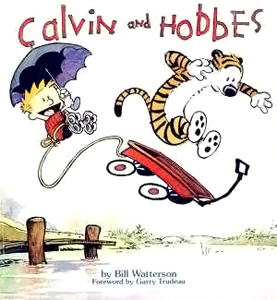
And today’s cultural climate might have made it more difficult for him to render a boy’s imaginative life in a realistic way. Calvin fantasizes not just about dinosaurs flying F-14s but also about shooting up his school with a tank. At one point, he tells Susie Derkins—his neighbor, rival and secret crush—“I’m sure it’s frustrating knowing that men are bigger, stronger and better at abstract thought than women.” That these are all jokes matters little. Enforcers of taste are not known for their humor. So one feels a double nostalgia in looking back at Mr. Watterson’s cartoons—first for an artist who is probably the greatest his genre has produced, second for the culture he spoke from, which was in ways freer than our own.
Calvin and Hobbes is a daily comic strip by American cartoonist Bill Watterson that was syndicated from November 18, 1985 to December 31, 1995. It follows the humorous antics of Calvin, a precocious, mischievous, and adventurous six-year-old boy, and Hobbes, his sardonic stuffed tiger. The pair is named after John Calvin, a 16th-century French Reformation theologian, and Thomas Hobbes, a 17th-century English political philosopher. At the height of its popularity, Calvin and Hobbes was featured in over 2,400 newspapers worldwide. (source: Wikipedia)
Christopher Caldwell is a senior editor at The Weekly Standard. His column on Bill Watterson and Calvin and Hobbes was featured recently in the Wall Street Journal.
Images: At right: The front cover art for the book Calvin and Hobbes written by Bill Watterson. Above: From ‘Exploring Calvin and Hobbes: An Exhibition Catalogue’ PHOTO: BILL WATTERSON (ANDREWS MCMEEL PUBLISHING)
Originally published on The Minot Voice: March 7, 2015
